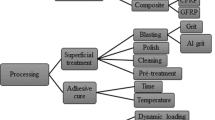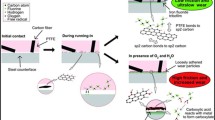Abstract
The effect of the pre-bond contamination with fingerprint (FP), both during the production and the application of adhesively bonded patch repairs on composite aircraft parts, and the cumulative effect of fingerprint and hygrothermal ageing on the fracture toughness of carbon fiber reinforced plastic (CFRP) bonded joints are experimentally investigated. To this end, mode I and mode II fracture toughness tests were conducted on FP contaminated coupons and mode II fracture toughness tests on FP contaminated and aged coupons. The artificial FP was supposed to mimic the accidentally applied fingerprints on the CFRP adherent and was applied on the adherent in the size of a human thumb. The two investigated FP formulations consisted of an artificial hand perspiration solution for the production scenario, and of Skydrol hydraulic-oil for the repair scenario. Three levels of contamination with FP were considered for each scenario. The hygrothermal ageing conditions applied until moisture saturation achieved were 70 °C/85% RH. Prior to bonding, the CFRP adherent surfaces were inspected using full-scale monitoring with optically stimulated electron emission (OSEE), an extended nondestructive testing method, in order to analyze the physicochemical variations at the contaminated surface of the adherents before bonding. The ANOVA statistical method was used to assist the evaluation of the results and the deduction or reliable conclusions. The results revealed that the pre-bond FP contamination of the adherents leads to the reduction of the fracture toughness of the CFRP bonded joints. After-bond hygrothermal ageing under the prescribed conditions had no significant influence on the moisture absorption and load carrying capacity of the joint. However, it influenced the bondline integrity as it led to a significant reduction of the fracture toughness of the joint. The effect of the combination of pre-bond contamination and after-bond hygrothermal ageing is more severe than the two separate effects.















Similar content being viewed by others
References
da Silva LFM, Öchsner A, Adams RD. Introduction to adhesive bonding technology. In: da Silva LFM, Öchsner A, Adams RD, editor. Handbook of Adhesion Technology 2nd Ed. Springer-Verlag: Heidelberg; 2011. p. 2–3
Pantelakis, S., Tserpes, K.I.: Adhesive bonding of composite aircraft structures: challenges and recent developments. Sci. China Phys. Mech. Astron. 57(1), 2–11 (2014). https://doi.org/10.1007/s11433-013-5274-3
Markatos, D.N., Tserpes, K.I., Rau, E., Markus, S., Ehrhart, B., Pantelakis, S.: The effects of manufacturing-induced and in-service related bonding quality reduction on the mode-I fracture toughness of composite bonded joints for aeronautical use. Composites Part B. 45(1), 556–564 (2013). https://doi.org/10.1016/j.compositesb.2012.05.052
Salvato M, De Vito S, Miglietta M, Massera E, Esposito E, Formisano F, Di Francia G. Hydraulic oil fingerprint contamination detection for aircraft CFRP maintenance by electronic nose. ISOCS/IEEE International Symposium on Olfaction and Electronic Nose (ISOEN); 2017 May 28–23; Montreal, QC. https://doi.org/10.1109/ISOEN.2017.7968872
Creemers F, Geurts KJ, Noeske M. Influence of surface contaminations on the quality and bond strength of structural adhesive joints. Paper presented at: European Adhesion (EURADH) Conference; 2016 September 21–23; University of Strathclyde, Glasgow, UK
Gause RL. A noncontacting scanning photoelectron emission technique for bonding surface cleanliness inspection. Paper presented at: fifth annual NASA NDE workshop; 1989; Florida, USA
Pitt, S., Jones, R., Peng, D.: Characterization of the durability of adhesive bonds. Fatigue Fract. Eng. Mater. Struct. 35(11), 998–1006 (2012). https://doi.org/10.1111/j.1460-2695.2012.01688.x
Johnson, W.S., Butkus, L.M.: Considering environmental conditions in the design of bonded structures: a fracture toughness mechanics approach. Fatigue Fract. Eng. Mater. Struct. 21(4), 465–478 (1998). https://doi.org/10.1046/j.1460-2695.1998.00533.x
Liljedahla, C.D.M., Crocombe, A.D., Wahaba, M.A., Ashcroft, I.A.: Modelling the environmental degradation of adhesively bonded aluminium and composite joints using a CZM approach. Int JAdhes Adhes. 27(6), 505–518 (2007). https://doi.org/10.1016/j.ijadhadh.2006.09.015
Soykok, I.F.: Degradation of single lap adhesively bonded composite joints due to hot water ageing. J. Adhes. 93(5), 357–374 (2017). https://doi.org/10.1080/00218464.2015.1076340
Reis, J.M.L., Andrade, B., Watanabe Jr., M.M., da Costa Mattos, H.S.: Influence of temperature on the bending stiffness and tensile-shear strength of composite–metal joints. J. Adhes. 94(14), 1122–1136 (2018). https://doi.org/10.1080/00218464.2017.1369407
Moutsompegka, E., Tserpes, K.I., Polydoropoulou, P., Tornow, C., Schlag, M., Brune, K., Mayer, B., Pantelakis, S.: Experimental study of the effect of pre-bond contamination with de-icing fluid and ageing on the fracture toughness of composite bonded joints. Fatigue Fract. Eng. Mater. Struct. 40(10), 1581–1591 (2017). https://doi.org/10.1111/ffe.12660
AITM 1–0053 (2006), AITM, Airbus Test Method, Carbon Fibre Reinforced Plastics, Determination of fracture toughness energy of bonded joints, Mode I, Airbus S.A.S, France, 2006
ISO 9022-12, Optics, and photonics -- Environmental test methods -- Part 12: Contamination, International Organization for Standardization, 2012
Tornow, C., Schlag, M., Lima Jr., L.C.M., Stübing, D., Hoffmann, M., Noeske, M., Brune, K., Dieckhoff, S.: Quality assurance concepts for adhesive bonding of composite aircraft structures – characterization of adherent surfaces by extended NDT. J. Adhes. Sci. Technol. 29(21), 2281–2294 (2015). https://doi.org/10.1080/01694243.2015.1055062
Davies, P., Benzeggagh, M.L.: Interlaminar mode-I fracture testing. In: Friedrich, K. (ed.) Application of Fracture Mechanics to Composite Materials. Elsevier Science Publishers BV, pp. 81–112 (1989). https://doi.org/10.1016/B978-0-444-87286-9.50007-3
ASTM D5573–99 (2005), Standard Practice for Classifying Failure Modes in Fiber-Reinforced-Plastic (FRP) Joints, ASTM International, West Conshohocken, PA, 2005, www.astm.org
de Oliveira, B.M.A., Campilho, R.D.S.G., Silva, F.J.G., Rocha, R.J.B.: Comparison between the ENF and 4ENF fracture characterization tests to evaluate GIIC of bonded aluminium joints. J. Adhes. 94(11), 910–931 (2018). https://doi.org/10.1080/00218464.2017.1387056
AITM 1–0006 (1994), AITM, Airbus Industry Test Method, Carbon Fibre Reinforced Plastics, Determination of interlaminar fracture toughness energy, Mode II, Airbus S.A.S, France, 1994
DIN EN 2823 Aerospace series—fibre reinforced plastics—determination of the effect of exposure to humid atmosphere on physical and mechanical characteristics. European Association of Aerospace Industries (AECMA), German Institute for Characterization (DIN). Brussels, Belgium, 1998
Stahle, L., Wold, S.: Analysis of variance (ANOVA). Chemom. Intell. Lab. Syst. 6(4), 259–272 (1989). https://doi.org/10.1016/0169-7439(89)80095-4
Bowditch, M.R.: The durability of adhesive joints in the presence of water. Int. J. Adhes. Adhes. 16(2), 73–79 (1996). https://doi.org/10.1016/0143-7496(96)00001-2
Acknowledgements
The research leading to these results has received funding from the European Union’s Horizon 2020 research and innovation program under grant agreement no 636494 (Project COMBONDT: Quality Assurance Concepts for Adhesive Bonding of Aircraft Composite Structures by Extended NDT).
Author information
Authors and Affiliations
Corresponding author
Additional information
Publisher’s Note
Springer Nature remains neutral with regard to jurisdictional claims in published maps and institutional affiliations.
Rights and permissions
About this article
Cite this article
Moutsompegka, E., Tserpes, K., Noeske, M. et al. Experimental Investigation of the Effect of Pre-Bond Contamination with Fingerprints and Ageing on the Fracture Toughness of Composite Bonded Joints. Appl Compos Mater 26, 1001–1019 (2019). https://doi.org/10.1007/s10443-019-09763-9
Received:
Accepted:
Published:
Issue Date:
DOI: https://doi.org/10.1007/s10443-019-09763-9




